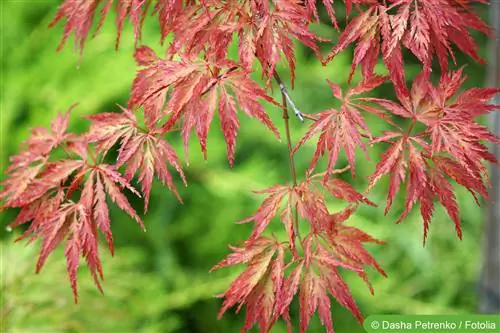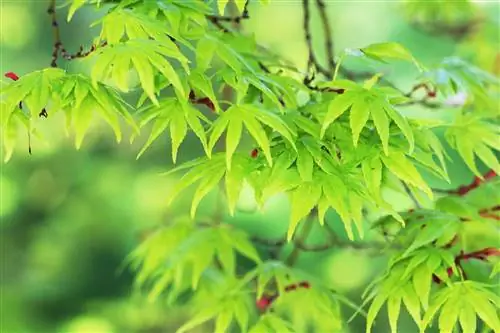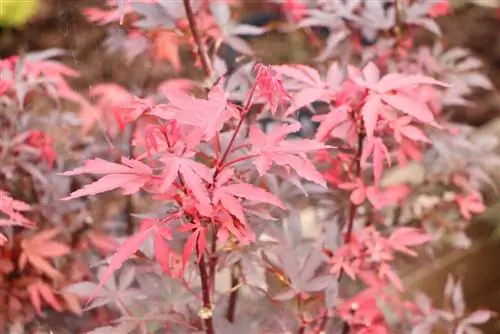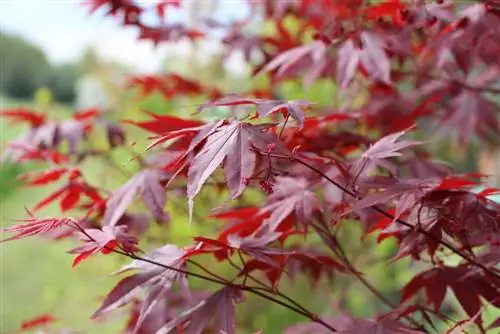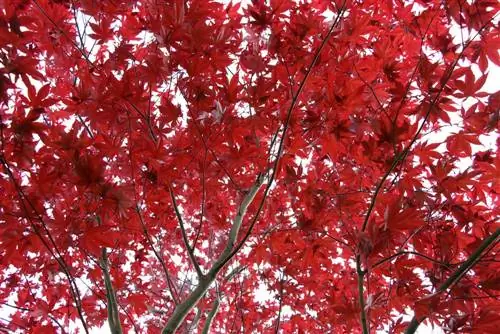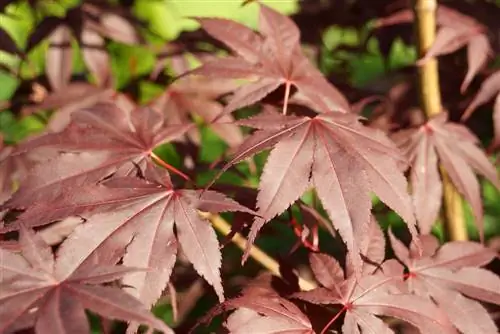- Author admin [email protected].
- Public 2023-12-17 03:39.
- Last modified 2025-01-24 12:45.
Acer japonicum is one of the most magnificent ornamental trees that can be found in home gardens. The summer-green, small trees shine in their full beauty, especially in autumn; the foliage varies during this time in the bright colors of red, yellow and orange. Well over 400 varieties of the maple plant are known, which differ from each other particularly in their foliage and growth form. Despite its expected height of around 10 meters, Japanese maple can also be easily cultivated in planters.
Location and soil
The planting location plays an important role in the deciduous tree. Particularly color-intensive varieties quickly lose their leaf color in a place that is too dark. In order for the respective Acer japonicum variety to feel comfortable, the requirements for the location must be met. Strikingly colorful maple plants prefer a full sun planting location. Other varieties, however, suffer burns on the leaves from direct and long-term sunlight. These representatives of the ornamental plants should therefore be cultivated in light partial shade. All types of Japanese maple prefer a wind-protected planting location with high humidity. In mid-summer you can lightly moisten the foliage of the leaves in the late afternoon with a water sprayer.
Tip:
Damage and discoloration of the foliage cannot be regenerated. The plant will only shine in its original splendor again when the new leaves sprout.
Soil plays an important role in Asian ornamental plants. To promote the resilience and growth of maple plants, you should pay attention to the following points:
- Substrate must be permeable and nutrient-rich.
- Soil with a neutral to slightly acidic pH value is ideal.
- Heavy soil should be loosened with sand or pebbles.
- Conventional potting soil mixed with humus is suitable for keeping in containers.
Watering and fertilizing
Dryness and waterlogging are two factors that Acer japonicum cannot tolerate at all. Never allow the root ball to dry out completely and water regularly, especially in midsummer. When planting outdoors, a watering edge has proven useful for the plants. If you have maple plants in a pot, you should create drainage at the bottom of the container to prevent standing moisture and the associated root rot. On hot summer days, water the plants early in the morning or late in the afternoon. This prevents the valuable liquid from evaporating quickly in the midday heat. With bark mulch you can not only prevent the growth of annoying weed species, but at the same time prevent the soil from drying out too quickly.
Japanese maple requires regular nutrients during the main growing season, which extends from March to the end of August. For ornamental trees planted directly in the garden, it is sufficient to mulch the soil every now and then and mix compost directly into the soil about every two months. A special long-term fertilizer has also proven effective. Potted plants, on the other hand, should be given liquid fertilizer every 4 to 6 weeks. This is added to the irrigation water, which ensures an even distribution in the substrate.
Plants
The Japanese ornamental plants can be cultivated just as easily in the pot as directly outdoors. However, with both types of plants it is important to meet the requirements for location and substrate. Acer japonicum is usually available in bales from nurseries or specialist retailers. Before planting, the roots should be able to soak up enough water for about 6 - 8 hours.
- The planting hole must have twice the circumference of the root ball of the ornamental tree.
- Mix the excavated earth with humus and, if necessary, with sand.
- Place the plant in the hole up to the upper root collar.
- Fill back the substrate and press it down carefully.
- Slurry the soil sufficiently.
Summer green trees are ideally planted in spring. This gives the plants enough time to take root until the coming winter. Keep the soil evenly moist and protect young plants - if possible - from the midday sun.
Acer japonicum in planters can be used in many ways. Whether as a decorative eye-catcher on a large terrace or as a solitary tree in the front garden. It is important that you use a sturdy bucket and place drainage made of porous material at the bottom. You can tell when it needs to be repotted because the roots of the plant fill the entire container.
Propagate
Japanese maple can be propagated by cuttings. To do this, a slightly woody shoot is cut to a length of 15 centimeters. So that the cutting puts its energy into developing roots, all of the foliage is removed except for two upper pairs of leaves. Lean substrate and a warm environment are ideal conditions for successful propagation. Place the cutting in humus-rich soil as soon as new shoots and leaves form. This measure is not always successful. Therefore, always cut several cuttings at the same time to increase the chances.
Cutting
Acer japonicum belongs to the type of deciduous plants that rarely or never require any topiary. In the worst case scenario, incorrect pruning can change the plant's characteristic growth habit and also lead to fungal spore infestation.
- In June, cut off the shoot tips directly above a bud.
- Cut out diseased and dead branches completely.
- Remove frozen shoots before the leaves emerge in spring.
- Crosswise growing branches - so-called water shoots - are cut in August at the latest.
Clean and disinfect the equipment used before and after work. This will prevent fungal spores and pests from multiplying uninhibitedly in the garden.
Wintering
Almost all commercially available varieties are hardy, but you should take a few precautions before the cold season:
- Stop supplying nutrients from August.
- In hardy regions, wrap the lower trunk with fleece.
- A layer of bark mulch about 3 to 5 centimeters thick protects the soil and the roots.
- Plant pots are wrapped thickly with burlap.
Despite all the precautionary measures, cold, wet weather and wind are particularly hard on ornamental trees in winter. Therefore, when planting, make sure that the selected location is protected from the wind. You can remove frozen shoots in early spring.
Diseases and pests
Maple trees are highly susceptible to verticillium wilt, a fungal disease that invades the plant from the ground. The fungus is often introduced into new plantings. You can recognize the infestation by the wilted leaves. Newly sprouted shoots suddenly show wilted leaves. The leaves are limp and have an unhe althy pale green color. Branches are also affected. The fungus clogs the water pipes. You can't fight him directly. Prevention is best. This includes maintaining the culture conditions as optimally as possible. Plant tonics can also be used. Lowering the pH value can reduce the risk of infection. The permanent bodies can be killed by professional composting. Usually the only option is to cut affected branches and shoots back to the he althy wood.
A Japanese Norway maple often has brown leaves. This could be because it is too wet or too dry. However, it may also have received too much sun. It also happens that he can't cope with cold winds. That's why a wind-protected location is important.
If you notice drill holes in the trunk of your maple or you find drill chips, it could be the citrus longhorn beetle. They are introduced into the tree nurseries with the plants from Asia. The pest is so dangerous that it even has to be reported. It spreads easily to many native tree species and causes them to die.
Conclusion
The plants with the strikingly colored leaves are an enrichment for any ornamental garden. Japanese maple is particularly effective as a solitary eye-catcher. Like any other plant, Acer japonicum has certain requirements for location and soil. If these are met, the ornamental tree will shine in its full foliage splendor. Contrary to what is often assumed, the care required for maple plants is limited. However, every hobby gardener should keep in mind that Acer japonicum is a small tree. Accordingly, a lot of space must be given to the plants when planting.
Care tips in brief
- The Japanese Norway maple does not belong in the blazing sun.
- It prefers broken sun or very light partial shade. If possible, the maple tree needs a place protected from the wind.
- The planting substrate should be nutrient-rich, slightly moist and water-permeable. The tree is sensitive to waterlogging.
- A medium to high humus content is favorable. In heavy clay soils, you should mix in peat moss to loosen the soil. The tree does not tolerate calcareous soil.
- The maple tree has many leaves and therefore evaporates a lot of water. The soil must therefore always be kept moist, but never wet. Waterlogging should be avoided.
- A frost-free location is recommended in winter. However, it should not be warmer than 8 ˚C at the location. The above-ground parts should be protected from cold, dry winds. The root ball must always be kept slightly moist. The plant substrate must never dry out completely.
- The easiest way to propagate the Japanese Norway maple is through seeds. Propagation from cuttings is also possible, but difficult. Propagation via cuttings is often not successful. Seeds are more suitable.

